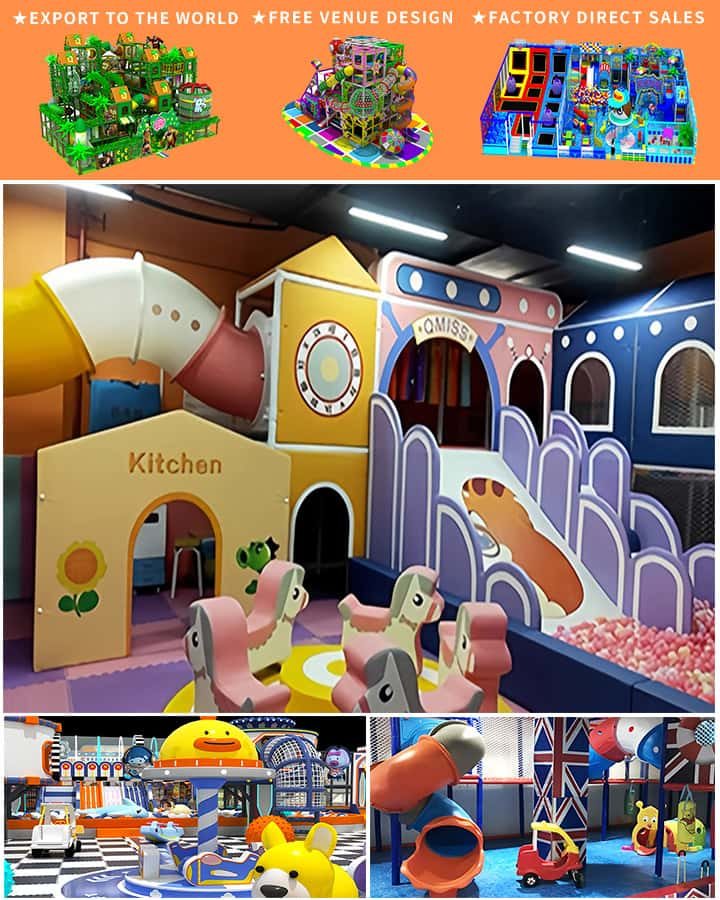In the realm of children’s recreational spaces, indoor playgrounds stand as vibrant havens where young imaginations can run wild and energy is boundless. Crafting an engaging and stimulating indoor playground requires more than just playful colors and fun equipment; it demands a thoughtful approach to design that caters to the diverse needs and developmental stages of children. Here are some innovative indoor playground design ideas that promise to inspire creativity and ensure endless hours of joyous exploration.
1. Themed Adventure Zones: Igniting Imagination
Transforming different sections of the playground into themed adventure zones is an excellent way to spark a child’s imagination. Whether it’s a pirate ship swashbuckling through uncharted waters, a jungle gym teeming with exotic creatures, or a space station brimming with interstellar excitement, these immersive environments encourage role-playing and narrative-building, fostering cognitive and social skills. Utilizing vibrant murals, thematic decor, and interactive elements within each zone enhances the experience, making every corner of the playground a world waiting to be explored.
2. Sensory Play Areas: Engaging All the Senses
Incorporating sensory play areas is crucial in an indoor playground, especially for younger children who learn and explore primarily through touch, sound, and sight. These areas can feature materials like textured walls, sand pits filled with colorful sand, water tables with floating toys, and musical instruments. Including elements that stimulate the senses not only provides endless entertainment but also supports sensory integration and fine motor skill development.

3. Multi-Level Challenge Courses: Promoting Physical Activity
To keep kids physically active and engaged, consider incorporating multi-level challenge courses. These courses can include climbing walls, slides, balance beams, and obstacle courses that require jumping, crawling, and navigating through various obstacles. By catering to different age groups and abilities, these structures promote gross motor skills, coordination, and confidence-building as children conquer each level.
4. Educational Corners: Learning Through Play
Integrating educational corners within the playground design offers a fantastic opportunity for children to learn while having fun. These corners can feature interactive exhibits such as puzzle boards, building blocks, alphabet and number games, and science experiments. Incorporating technology in moderation, such as tablets with educational apps or interactive whiteboards, can further enrich the learning experience without overwhelming the senses.
5. Cozy Reading Nooks: Encouraging Literacy
Creating cozy reading nooks amidst the hustle and bustle of the playground encourages a love for books and quiet time. These nooks can be equipped with comfortable seating, soft lighting, and a selection of age-appropriate books spanning various genres. Adding small tables for drawing or coloring activities adjacent to the reading area promotes creativity while providing a tranquil space for relaxation.
6. Soft Play Zones: Safety First
Safety is paramount in any indoor playground design, particularly for toddlers and preschoolers. Soft play zones filled with foam shapes, cushioned mats, and padded structures offer a secure environment for little ones to tumble, climb, and explore without fear of injury. These areas often feature gentle slopes, tunnels, and ball pits, promoting physical activity while ensuring peace of mind for parents.
7. Parent and Toddler Interaction Spaces: Bonding Time
Recognizing the importance of parental involvement, designing specific areas where parents can actively engage with their children is essential. Interactive flooring with built-in games, shared craft tables, or parent-child cooking corners provide opportunities for bonding and cooperative play. This not only strengthens familial bonds but also creates a supportive environment where children feel encouraged and valued.
Conclusion: A World of Possibilities
An indoor playground designed with creativity and intentionality becomes more than just a place for kids to play; it transforms into a nurturing environment that fosters physical, cognitive, and emotional growth. By integrating themed zones, sensory experiences, educational resources, and safe spaces for all ages, designers can create a dynamic playground that captivates young minds and bodies alike. Remember, the key lies in blending fun with functionality, ensuring every element contributes to the overall joy and development of the children who venture into this imaginative world.




